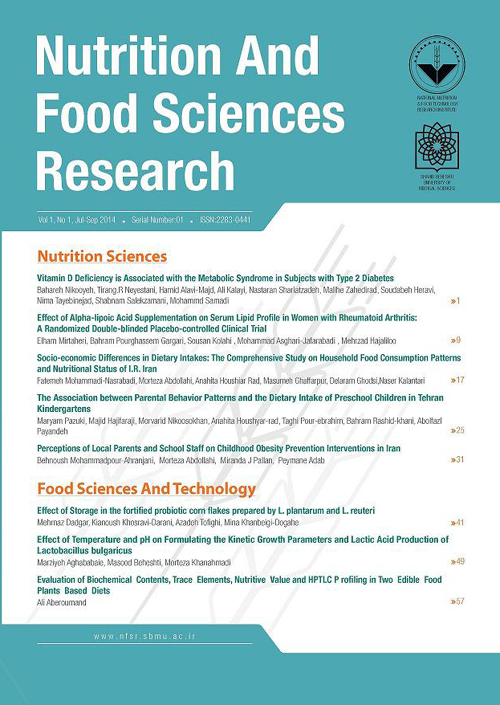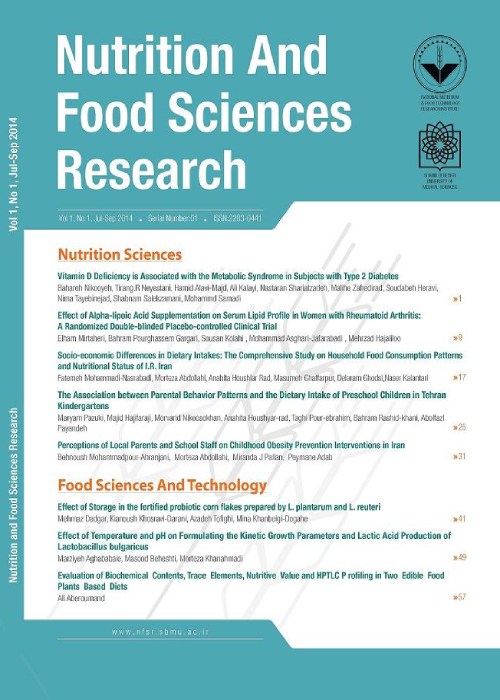فهرست مطالب

Nutrition & Food Technology Research
Volume:9 Issue: 2, Apr-Jun 2022
- تاریخ انتشار: 1401/04/18
- تعداد عناوین: 7
-
-
Pages 1-2
-
Pages 3-8Background and Objectives
Tuberculosis is one of the major health problems in Bangladesh as well as other regions of the world. The aim of this clinical trial was to investigate combined effects of vitamin C and anti-tuberculosis drugs in tuberculosis patients.
Materials and MethodsA total of 32 tuberculosis patients were enrolled in the study through random sampling and separated into intervention (vitamin C and anti-tuberculosis drugs) and control (only anti-tuberculosis drugs) groups, where the intervention group was treated with 1000 mg of vitamin C daily in addition to anti-tuberculosis drugs and the control group was treated with only anti-tuberculosis drugs for 28 days. In the second stage, the microbial count of tuberculosis patients was assessed using sputum smear test for control and intervention groups after a 7-d time interval.
ResultsSmear test of the patient first week showed that the microbial loads comparatively decreased compared to the test of the second week using combined treatment of vitamin C and anti-tuberculosis drugs for the intervention group (p=0.034). In contrast, the control group included p=0.000, p=0.341 and p=0.346 for the second, third and fourth-week tests with no significance.
ConclusionsCombined effects of vitamin C and anti-tuberculosis drugs in TB patients.
Keywords: Tuberculosis, Treatment, Vitamin C, Tuberculosis drugs -
Pages 9-15Background and Objectives
Increased dietary inflammatory index can be one of the factors affecting brain function and occurrence of academic failure in adolescents. There are evidence that diet modification in adolescents and anti-inflammatory diets play important roles in improving intelligence quotient and further academic achievements in adolescents. The aim of this study was to investigate relationships between dietary inflammatory index and intelligence quotient in adolescent girls.
Materials and MethodsIn this cross-sectional study, 162 female students were selected using cluster sampling. Raven intelligence quotient test was used to measure student intelligence quotient. Dietary inflammatory index score was calculated through food data collected using 3-day food recalls.
ResultsThe mean age of the 162 students was 16.3 y ±1.06 and the mean value of using intelligence was 103± 9.8. Nearly 74% of the students had moderate intelligence and 17% were smart.The mean dietary inflammatory index score in these individuals was -0.08 ±1.54. No significant relationships were seen between dietary inflammatory index and intelligence quotient in the crude model and after adjusting for confounding variables.
ConclusionsNo significant relationships were reported between diet inflammatory index score and intelligence quotient in adolescents. Extensive and prospective studies on genetic and environmental factors affecting intelligence quotient are recommended.
Keywords: Dietary inflammatory index, Intelligence quotient, Adolescent -
Pages 17-21Background and Objectives
Mineral and drinking waters are categorized bottled waters in the national standard of Iran and use of bottled waters is most linked to their health issues. Anions such as nitrite, nitrate, fluoride, chloride, sulfate and phosphate are important in assessing source and time of contamination in the purification water industry. National and international standards have been set and justified for the permissible levels for the highlighted anions.
Materials and MethodsTotally, 168 minerals and drinking bottled water samples from the Iranian markets were collected under ideal sampling conditions and analyzed using ion chromatography (IC) featured with a conductivity detector.
ResultsResults showed that four anions, including nitrate, fluoride, chloride and sulfate, in all samples were detectable with mean values of 0.131, 6.77, 25.109 and 20.97 ppb, respectively, which were lower than the maximum standard levels. Nitrate and phosphate were not detected in 86% of the samples and included very low levels in other samples.
ConclusionsIt can be concluded that the anions are reliable sources of contamination and their monitoring is necessary for the product safety and consumer health.
Keywords: Bottled water, Anions, Product safety, Ion chromatography -
Pages 23-29Background and Objectives
Clinical evidence on the nutritional statuses of COVID-19 patients and their associations with COVID-19 clinical outcomes are limited. To the best of the authors’ knowledge, no studies have been carried out on COVID-19 patients of Iranian population. Therefore, the aim of this study was to assess vitamin D, vitamin B12, RBP, zinc, selenium, copper and magnesium levels in patients with COVID-19. Furthermore, associations of nutrient levels with the disease-linked death were investigated.
Materials and MethodsThis cross-sectional study was carried out in hospitals affiliated to Hamadan University of Medical Sciences, Hamadan, Iran, on 98 COVID-19 positive patients, March to May 2020. Demographic and clinical data of the patients were collected from their clinical records. Blood samples of 5 ml were collected from the patients, which were used for hospital routine laboratory assays as well as measuring trace elements and vitamins. Comparison of chemical biomarkers based on the patient’s treatment outcomes was carried out using Mann-Whitney U test. For data analysis, Stata Software v.14 was used.
ResultsFrom 98 COVID-19 positive patients, 16 (13.33%) patients died during the treatment. These patients had higher proportions of heart diseases (37.5% against 10.98%, p = 0.007). Moreover, the median of white blood cell counts was significantly higher in patients, who died during treatment (p = 0.002). For vitamin D3, vitamin B12, RBP, zinc, selenium, cupper and magnesium, 59.2, 12.24, 53.08, 30.61, 88.71, 16.33 and 26.53% of the patients had values below the reference value ranges of these elements, respectively. Comparison of chemical biomarkers based on the patient’s treatment outcomes did not show significant differences (p > 0.05).
ConclusionsAlthough results of this study did not show significant differences between the levels of the trace elements and vitamins with the outcomes in COVID-19 patients due to the small sample size of the present study, assessment of these relationships needs stronger evidence by designing large studies.
Keywords: COVID-19, Vitamin D, Vitamin B12, Zinc, Selenium, Copper, Magnesium, Iran -
Pages 31-38Background and Objectives
Shortenings are fats used mainly in the formulation of bakery, confectionery, dairy, and frying products. The aim of this study was to assess the physicochemical properties and trans fatty acid (TFA) content of shortenings produced in Iran.
Materials and MethodsSamples of 15 shortening brands produced in Iran (summer of 2016) were collected and characterized for their physicochemical properties.
ResultsIranian shortenings contained 0.21-15.54% TFA and 40.08-59.54% saturated fatty acids. The iodine value of Iranian shortenings was between 40.84 and 73.32. Lovibond yellow and red color indices of the samples were 2.1-13.6 and 28-70.4, respectively. The induction period of oxidation at 110°C (IP110) of the samples was between 10.03 and 44.02 h. The slip melting point of the shortenings was between 42.5 and 49.3°C. Solid fat content of Iranian shortenings was 40.6-75.0% at 10°C, 24.2-59.5% at 20°C, 11.4-36.4% at 30°C, 7.8-27.3% at 35°C, and 3.1-17.4% at 40°C. Free fatty acid (FFA) content of shortenings ranged from 0.02 to 0.92%, and peroxide value was between 1.0 and 3.0 meq/kg.
ConclusionsCompared to the national standard for the specification of shortenings, 20.0% of samples had TFA content higher than the standard level (5%). Additionally, 13.3% of samples did not meet the standard limits of lauric acid content, 46.7% had FFA contents above and 53.3% showed IP110 below the standard level. Accordingly, efficient control protocols should be established by the authorities to assure the production of shortenings with the standard properties.
Keywords: Shortenings, Physicochemical properties, Trans fatty acids, Saturated fatty acids -
Pages 39-44Background and Objectives
Bread of any kind is a staple food in many countries and supplies some important macro- and micro-nutrients. Now global challenges such as climate change, drought and wars have triggered increase in wheat price, and thus, food insecurity.
Materials and MethodsTo reduce bread waste and increase its productivity, we studied the effect of adding toast bread waste powder at the levels of 2, 3, 5 and 7% (samples 2-5, respectively) to dough as flour substitution, on toast bread properties. Other ingredients and bakery processes were the same as the control bread (sample 1). Moisture, porosity and specific volume of all samples were determined. Finally, rheological tests (hardness, adhesiveness, cohesiveness, gumminess, springiness and chewiness) and sensory evaluation (crust and crumb color, taste, chewability, surface shape and overall acceptability) were carried out.
ResultsThe results showed that by increasing the inclusion rate of bread waste into the dough, the bread’s moisture content was increased significantly while its porosity and specific volume were declined. Although some rheological attributes (hardness and chewiness) did not present clear trends, there was a negative relation between springiness and the substitution levels on both days (1 and 3) while adhesiveness on day 1 and gumminess on day 3 displayed positive correlation with bread waste inclusion. In sensory data analysis, samples 2 and 3 appeared to be more similar to the control one.
ConclusionsThe authors recommend up to 2% of flour substitution by bread waste, which had no significant or minimal effect on toast bread properties.
Keywords: Toast bread, Process waste, Rheology, Sensory evaluation


